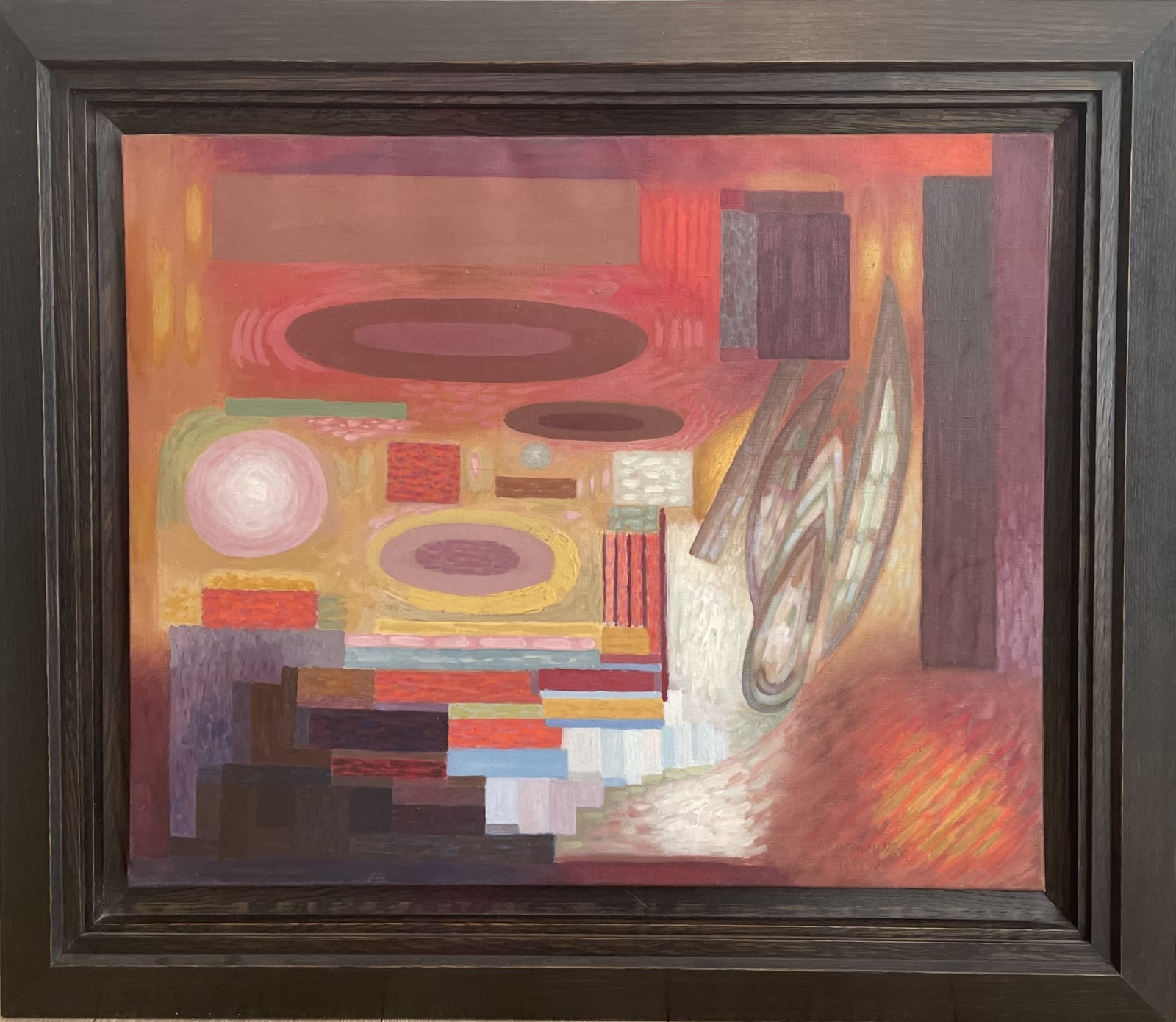Serge Charchoune Russian, 1888-1975
La Chute de l'Ange, 1954
Oil on canvas
50 x 61 cm
Signed and dated "Charchoune IV 54"
From the 1940s onwards, Charchoune abandons the Purism of Ozenfant and Le Corbusier and returns to a more ornamental, colourful and vibrant Cubism. His "musicalist compositions" from this period show a real search for formal and colourful rhythm, and the artist's touch becomes freer and more divisionist.
Charchoune carried with him the vast ornamental and folkloric tradition of his native Russia, as well as the popular Spanish art he had come to appreciate during his travels during the Great War. But more than just "ornamental cubism", colour and form became symbols, just as in Slavic folk art: a modern icon.
Charchoune painted during this period while listening to classical music. It is no coincidence that most of his compositions bear musical titles or subtitles: Lohengrin (1954), La Walkyrie (1955), or, in this case, Trio piano, flute and cello. With its alternative title, "Le Vaiseau fantome", this canvas is inspired by the Wagner opera of the same name, "The Flying Dutchman". The opera depicts the frantic race of the Flying Dutchman, a creature between Heaven and Hell, a cursed sailor condemned to wander the oceans eternally for having defied God and in search of salvation, which he will only find in the absolute love of a woman. The heroine, Senta, has sworn to this man that she is his forever. In the last act, convinced of the young woman's betrayal, the Dutchman reveals his sad fate to her and boards his ghost ship, with no hope of redemption. Distraught and completely at his mercy, the angel-like Senta throws herself off a cliff into the ocean, offering her life in a final gesture of salvation.The transfigured silhouettes of Senta and the Dutchman rise towards the sky, above the Phantom Ship engulfed by the waves.
From the very beginnings of abstraction, its relationship with music was fertile - one of Kupka's first abstract canvases is a variation on piano keyboards. Rather than focusing on theory, Charchoune let his dreams and imagination dictate the act of painting, trying to translate music into his curves, circles, verticals and horizontals. "It's my food," says the artist. He painted quickly, in dabs, in a tachist manner reminiscent of Seurat, but his palette of reds, violets and yellows and that of Diaghilev's ballet.
From the 1940s onwards, Charchoune abandons the Purism of Ozenfant and Le Corbusier and returns to a more ornamental, colourful and vibrant Cubism. His "musicalist compositions" from this period show a real search for formal and colourful rhythm, and the artist's touch becomes freer and more divisionist.
Charchoune carried with him the vast ornamental and folkloric tradition of his native Russia, as well as the popular Spanish art he had come to appreciate during his travels during the Great War. But more than just "ornamental cubism", colour and form became symbols, just as in Slavic folk art: a modern icon.
Charchoune painted during this period while listening to classical music. It is no coincidence that most of his compositions bear musical titles or subtitles: Lohengrin (1954), La Walkyrie (1955), or, in this case, Trio piano, flute and cello. With its alternative title, "Le Vaiseau fantome", this canvas is inspired by the Wagner opera of the same name, "The Flying Dutchman". The opera depicts the frantic race of the Flying Dutchman, a creature between Heaven and Hell, a cursed sailor condemned to wander the oceans eternally for having defied God and in search of salvation, which he will only find in the absolute love of a woman. The heroine, Senta, has sworn to this man that she is his forever. In the last act, convinced of the young woman's betrayal, the Dutchman reveals his sad fate to her and boards his ghost ship, with no hope of redemption. Distraught and completely at his mercy, the angel-like Senta throws herself off a cliff into the ocean, offering her life in a final gesture of salvation.The transfigured silhouettes of Senta and the Dutchman rise towards the sky, above the Phantom Ship engulfed by the waves.
From the very beginnings of abstraction, its relationship with music was fertile - one of Kupka's first abstract canvases is a variation on piano keyboards. Rather than focusing on theory, Charchoune let his dreams and imagination dictate the act of painting, trying to translate music into his curves, circles, verticals and horizontals. "It's my food," says the artist. He painted quickly, in dabs, in a tachist manner reminiscent of Seurat, but his palette of reds, violets and yellows and that of Diaghilev's ballet.
Provenance
Atelier de l’artisteGalerie Raymond Creuze
Galerie Thessa Hérold, 2007
Private collection, France (acquired from the former)
Private collection, France
Exhibitions
Serge Charchoune, Le Soleil russe, 2007, Galerie Thessa Herold, Paris.Literature
Charchouniana, Raymond Creuze, 1989, Paris, reproduit p. 105.
Serge Charchoune, Le Soleil russe, 2007, cat. expo. Galerie Thessa Herold, Paris.
Publications
This work benefits from a certificate established by M. Guénégan, and will be published in the upcoming supplement of the Catalogue raisonné of Serge Charchoune.1
of
2
